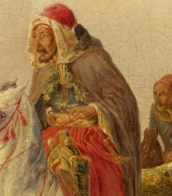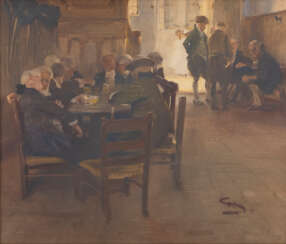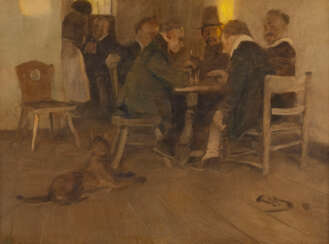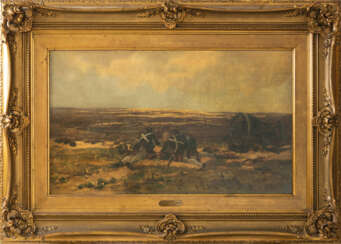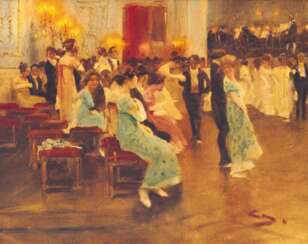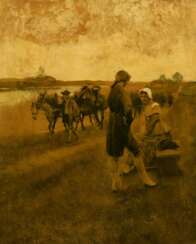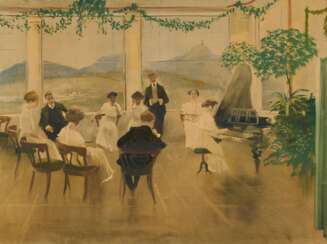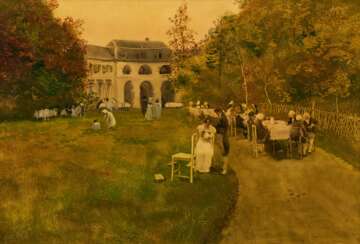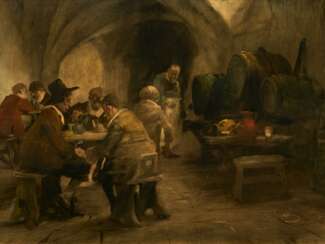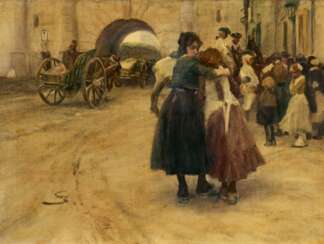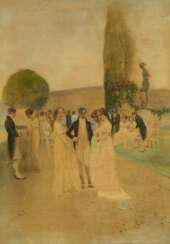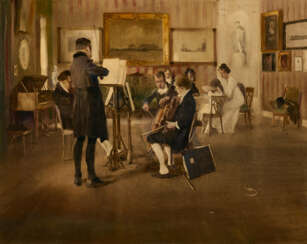вильгельм шройер (1866 - 1933)
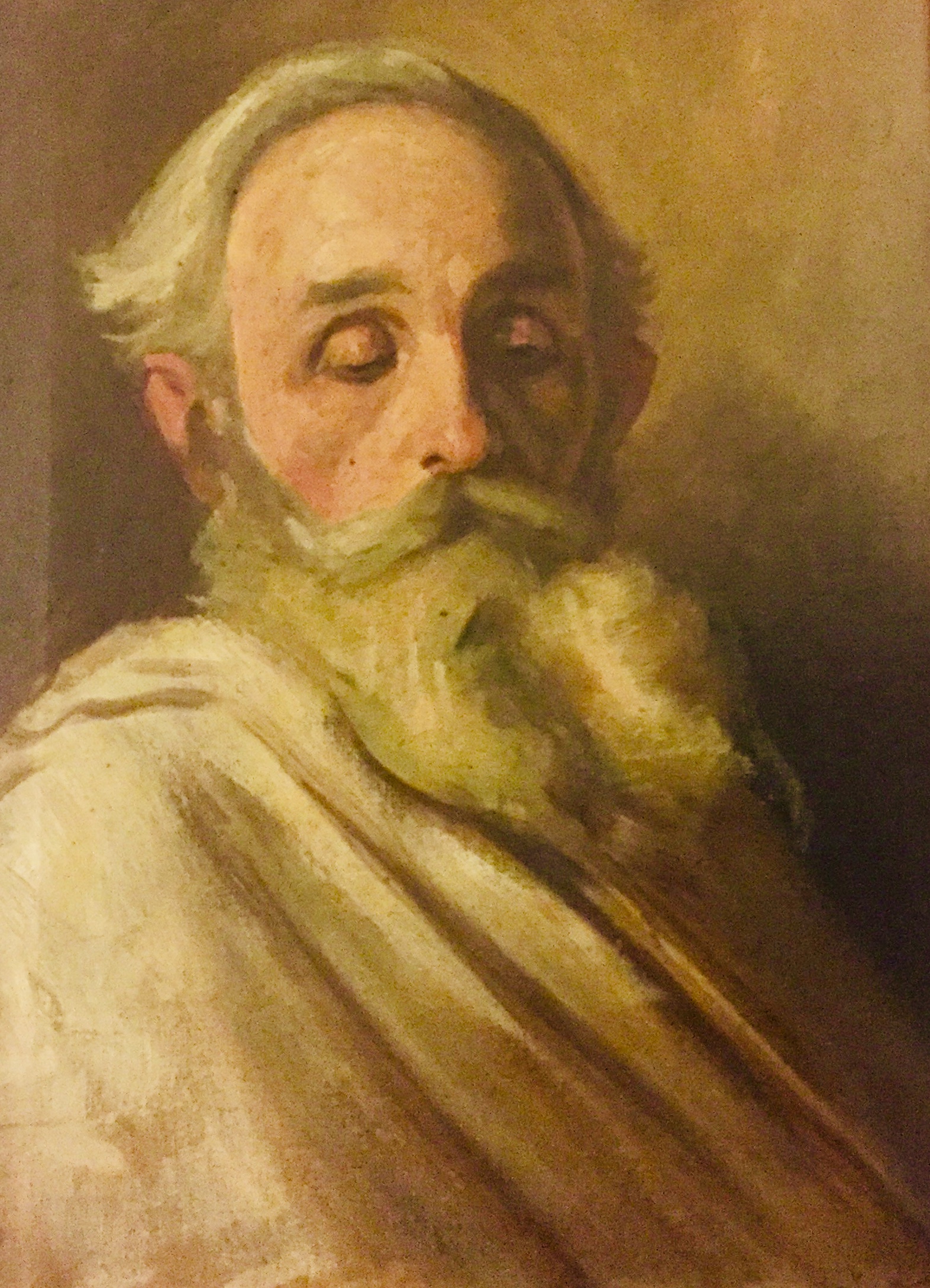
Wilhelm Schreuer was a German painter; associated with the Düsseldorfer Malerschule.
Most of his works were created with a distinctive technique, involving diluted colors on a damp surface, applied to glued paper; a method that makes major corrections almost impossible. The resulting surface is smooth as glass. Often, the effect is nearly monochromatic. Although he painted a wide variety of subjects, scenes from inns, restaurants, dance halls, and various events were obviously his favorites.
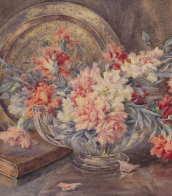

Wilhelm Schreuer was a German painter; associated with the Düsseldorfer Malerschule.
Most of his works were created with a distinctive technique, involving diluted colors on a damp surface, applied to glued paper; a method that makes major corrections almost impossible. The resulting surface is smooth as glass. Often, the effect is nearly monochromatic. Although he painted a wide variety of subjects, scenes from inns, restaurants, dance halls, and various events were obviously his favorites.


Wilhelm Schreuer was a German painter; associated with the Düsseldorfer Malerschule.
Most of his works were created with a distinctive technique, involving diluted colors on a damp surface, applied to glued paper; a method that makes major corrections almost impossible. The resulting surface is smooth as glass. Often, the effect is nearly monochromatic. Although he painted a wide variety of subjects, scenes from inns, restaurants, dance halls, and various events were obviously his favorites.


Wilhelm Schreuer was a German painter; associated with the Düsseldorfer Malerschule.
Most of his works were created with a distinctive technique, involving diluted colors on a damp surface, applied to glued paper; a method that makes major corrections almost impossible. The resulting surface is smooth as glass. Often, the effect is nearly monochromatic. Although he painted a wide variety of subjects, scenes from inns, restaurants, dance halls, and various events were obviously his favorites.


Wilhelm Schreuer was a German painter; associated with the Düsseldorfer Malerschule.
Most of his works were created with a distinctive technique, involving diluted colors on a damp surface, applied to glued paper; a method that makes major corrections almost impossible. The resulting surface is smooth as glass. Often, the effect is nearly monochromatic. Although he painted a wide variety of subjects, scenes from inns, restaurants, dance halls, and various events were obviously his favorites.
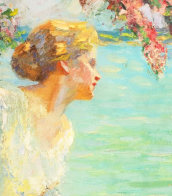

Wilhelm Schreuer was a German painter; associated with the Düsseldorfer Malerschule.
Most of his works were created with a distinctive technique, involving diluted colors on a damp surface, applied to glued paper; a method that makes major corrections almost impossible. The resulting surface is smooth as glass. Often, the effect is nearly monochromatic. Although he painted a wide variety of subjects, scenes from inns, restaurants, dance halls, and various events were obviously his favorites.
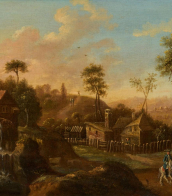

Wilhelm Schreuer was a German painter; associated with the Düsseldorfer Malerschule.
Most of his works were created with a distinctive technique, involving diluted colors on a damp surface, applied to glued paper; a method that makes major corrections almost impossible. The resulting surface is smooth as glass. Often, the effect is nearly monochromatic. Although he painted a wide variety of subjects, scenes from inns, restaurants, dance halls, and various events were obviously his favorites.
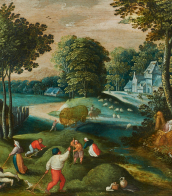

Wilhelm Schreuer was a German painter; associated with the Düsseldorfer Malerschule.
Most of his works were created with a distinctive technique, involving diluted colors on a damp surface, applied to glued paper; a method that makes major corrections almost impossible. The resulting surface is smooth as glass. Often, the effect is nearly monochromatic. Although he painted a wide variety of subjects, scenes from inns, restaurants, dance halls, and various events were obviously his favorites.
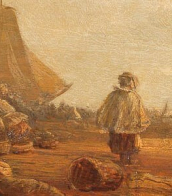

Wilhelm Schreuer was a German painter; associated with the Düsseldorfer Malerschule.
Most of his works were created with a distinctive technique, involving diluted colors on a damp surface, applied to glued paper; a method that makes major corrections almost impossible. The resulting surface is smooth as glass. Often, the effect is nearly monochromatic. Although he painted a wide variety of subjects, scenes from inns, restaurants, dance halls, and various events were obviously his favorites.


Wilhelm Schreuer was a German painter; associated with the Düsseldorfer Malerschule.
Most of his works were created with a distinctive technique, involving diluted colors on a damp surface, applied to glued paper; a method that makes major corrections almost impossible. The resulting surface is smooth as glass. Often, the effect is nearly monochromatic. Although he painted a wide variety of subjects, scenes from inns, restaurants, dance halls, and various events were obviously his favorites.
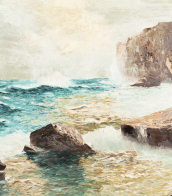

Wilhelm Schreuer was a German painter; associated with the Düsseldorfer Malerschule.
Most of his works were created with a distinctive technique, involving diluted colors on a damp surface, applied to glued paper; a method that makes major corrections almost impossible. The resulting surface is smooth as glass. Often, the effect is nearly monochromatic. Although he painted a wide variety of subjects, scenes from inns, restaurants, dance halls, and various events were obviously his favorites.


Wilhelm Schreuer was a German painter; associated with the Düsseldorfer Malerschule.
Most of his works were created with a distinctive technique, involving diluted colors on a damp surface, applied to glued paper; a method that makes major corrections almost impossible. The resulting surface is smooth as glass. Often, the effect is nearly monochromatic. Although he painted a wide variety of subjects, scenes from inns, restaurants, dance halls, and various events were obviously his favorites.


Wilhelm Schreuer was a German painter; associated with the Düsseldorfer Malerschule.
Most of his works were created with a distinctive technique, involving diluted colors on a damp surface, applied to glued paper; a method that makes major corrections almost impossible. The resulting surface is smooth as glass. Often, the effect is nearly monochromatic. Although he painted a wide variety of subjects, scenes from inns, restaurants, dance halls, and various events were obviously his favorites.
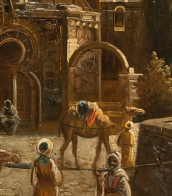

Wilhelm Schreuer was a German painter; associated with the Düsseldorfer Malerschule.
Most of his works were created with a distinctive technique, involving diluted colors on a damp surface, applied to glued paper; a method that makes major corrections almost impossible. The resulting surface is smooth as glass. Often, the effect is nearly monochromatic. Although he painted a wide variety of subjects, scenes from inns, restaurants, dance halls, and various events were obviously his favorites.
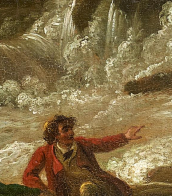

Wilhelm Schreuer was a German painter; associated with the Düsseldorfer Malerschule.
Most of his works were created with a distinctive technique, involving diluted colors on a damp surface, applied to glued paper; a method that makes major corrections almost impossible. The resulting surface is smooth as glass. Often, the effect is nearly monochromatic. Although he painted a wide variety of subjects, scenes from inns, restaurants, dance halls, and various events were obviously his favorites.


Wilhelm Schreuer was a German painter; associated with the Düsseldorfer Malerschule.
Most of his works were created with a distinctive technique, involving diluted colors on a damp surface, applied to glued paper; a method that makes major corrections almost impossible. The resulting surface is smooth as glass. Often, the effect is nearly monochromatic. Although he painted a wide variety of subjects, scenes from inns, restaurants, dance halls, and various events were obviously his favorites.


Wilhelm Schreuer was a German painter; associated with the Düsseldorfer Malerschule.
Most of his works were created with a distinctive technique, involving diluted colors on a damp surface, applied to glued paper; a method that makes major corrections almost impossible. The resulting surface is smooth as glass. Often, the effect is nearly monochromatic. Although he painted a wide variety of subjects, scenes from inns, restaurants, dance halls, and various events were obviously his favorites.


Wilhelm Schreuer was a German painter; associated with the Düsseldorfer Malerschule.
Most of his works were created with a distinctive technique, involving diluted colors on a damp surface, applied to glued paper; a method that makes major corrections almost impossible. The resulting surface is smooth as glass. Often, the effect is nearly monochromatic. Although he painted a wide variety of subjects, scenes from inns, restaurants, dance halls, and various events were obviously his favorites.


Wilhelm Schreuer was a German painter; associated with the Düsseldorfer Malerschule.
Most of his works were created with a distinctive technique, involving diluted colors on a damp surface, applied to glued paper; a method that makes major corrections almost impossible. The resulting surface is smooth as glass. Often, the effect is nearly monochromatic. Although he painted a wide variety of subjects, scenes from inns, restaurants, dance halls, and various events were obviously his favorites.
